Norne: Real field black-oil model
The Norne model is a real field model. The model has been adapted so that the input file only contains features present in JutulDarcy, with the most notable omissions being removal of hysteresis and threshold pressures between equilibriation reqgions. For more details, see the OPM data webpage
julia
using Jutul, JutulDarcy, GLMakie, DelimitedFiles, HYPRE, GeoEnergyIO
norne_dir = GeoEnergyIO.test_input_file_path("NORNE_NOHYST")
data_pth = joinpath(norne_dir, "NORNE_NOHYST.DATA")
data = parse_data_file(data_pth)
case = setup_case_from_data_file(data);[33;1mF-4H completion:[0m Removed COMPDAT as (36, 68, 17) is not active in processed mesh.
[94;1mRel. Perm. Scaling:[0m Three-point scaling active.
[94;1mShutting D-1H:[0m Well has no open perforations at step 137, shutting.
┌ Warning: Negative saturation in 215 cells for phase 2. Normalizing.
└ @ JutulDarcy ~/work/JutulDarcy.jl/JutulDarcy.jl/src/init/init.jl:787
[94;1mTransmissibility:[0m Replaced 2 non-finite half-transmissibilities (out of 267694, 0.0%) with zero.
[94;1mTransmissibility:[0m Replaced 2 non-finite half-transmissibilities (out of 267694, 0.0%) with zero.Unpack the case to see basic data structures
julia
model = case.model
parameters = case.parameters
forces = case.forces
dt = case.dt;Plot the reservoir mesh, wells and faults
We compose a few different plotting calls together to make a plot that shows the outline of the mesh, the fault structures and the well trajectories.
julia
import Jutul: plot_mesh_edges!
reservoir = reservoir_domain(model)
mesh = physical_representation(reservoir)
wells = get_model_wells(model)
fig = Figure(size = (1200, 800))
ax = Axis3(fig[1, 1], zreversed = true)
plot_mesh_edges!(ax, mesh, alpha = 0.5)
for (k, w) in wells
plot_well!(ax, mesh, w)
end
plot_faults!(ax, mesh, alpha = 0.5)
ax.azimuth[] = -3.0
ax.elevation[] = 0.5
fig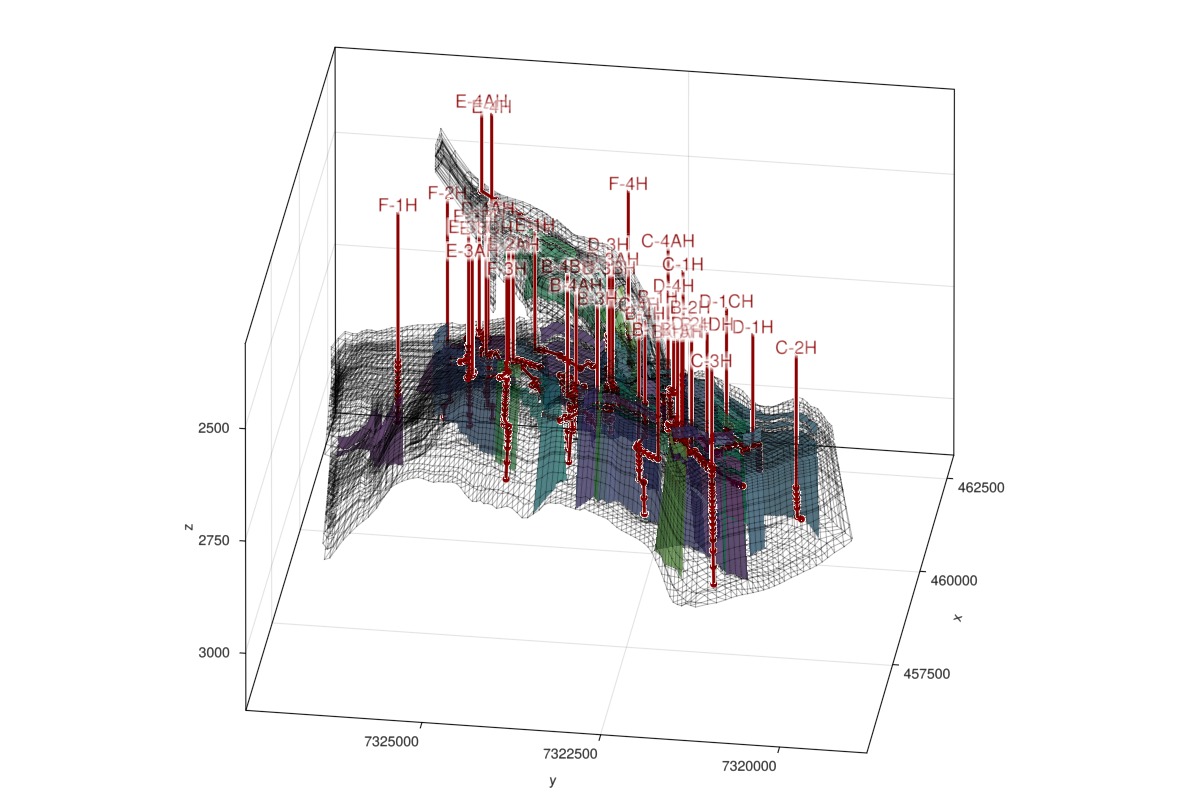
Plot the reservoir static properties in interactive viewer
julia
fig = plot_reservoir(model, key = :porosity)
ax = fig.current_axis[]
plot_faults!(ax, mesh, alpha = 0.5)
ax.azimuth[] = -3.0
ax.elevation[] = 0.5
fig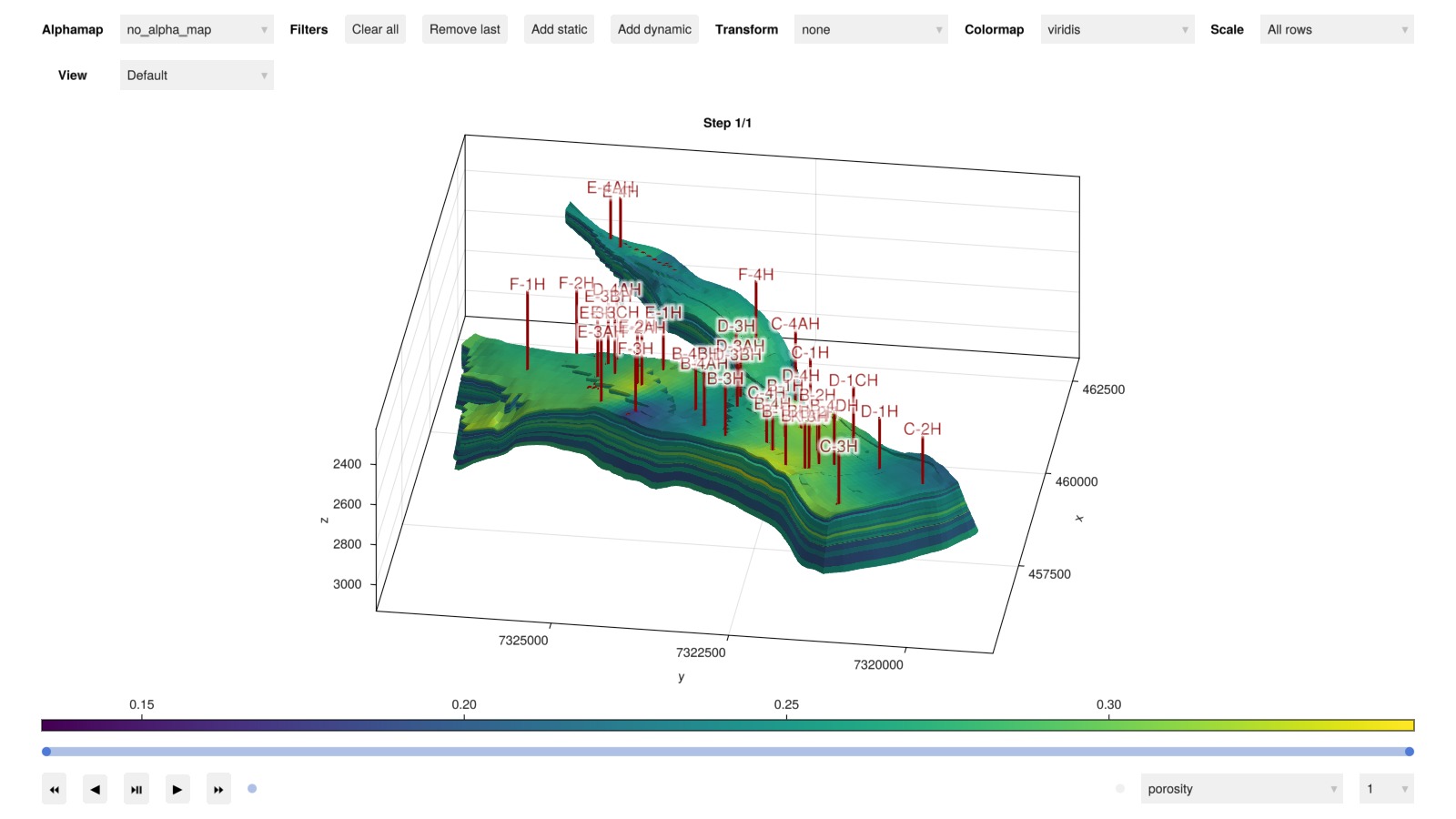
Simulate the model
julia
ws, states = simulate_reservoir(case, output_substates = true)ReservoirSimResult with 463 entries:
wells (36 present):
:B-4H
:F-4H
:D-4H
:F-2H
:D-2H
:B-1H
:C-4H
:C-1H
:B-2H
:E-1H
:B-4BH
:D-3AH
:D-3BH
:C-3H
:E-3H
:K-3H
:E-4AH
:D-1H
:B-1AH
:E-3CH
:E-4H
:E-2H
:E-2AH
:C-4AH
:B-1BH
:C-2H
:B-4DH
:D-3H
:E-3AH
:D-4AH
:B-3H
:F-3H
:E-3BH
:D-1CH
:F-1H
:B-4AH
Results per well:
:wrat => Vector{Float64} of size (463,)
:Aqueous_mass_rate => Vector{Float64} of size (463,)
:orat => Vector{Float64} of size (463,)
:bhp => Vector{Float64} of size (463,)
:lrat => Vector{Float64} of size (463,)
:mass_rate => Vector{Float64} of size (463,)
:rate => Vector{Float64} of size (463,)
:Vapor_mass_rate => Vector{Float64} of size (463,)
:control => Vector{Symbol} of size (463,)
:Liquid_mass_rate => Vector{Float64} of size (463,)
:grat => Vector{Float64} of size (463,)
states (Vector with 463 entries, reservoir variables for each state)
:Rv => Vector{Float64} of size (44417,)
:BlackOilUnknown => Vector{BlackOilX{Float64}} of size (44417,)
:Saturations => Matrix{Float64} of size (3, 44417)
:Pressure => Vector{Float64} of size (44417,)
:Rs => Vector{Float64} of size (44417,)
:ImmiscibleSaturation => Vector{Float64} of size (44417,)
:TotalMasses => Matrix{Float64} of size (3, 44417)
time (report time for each state)
Vector{Float64} of length 463
result (extended states, reports)
SimResult with 247 entries
extra
Dict{Any, Any} with keys :simulator, :config
Completed at Oct. 01 2024 16:10 after 11 minutes, 16 seconds, 842.8 milliseconds.Plot the reservoir solution
julia
fig = plot_reservoir(model, states, step = 247, key = :Saturations)
ax = fig.current_axis[]
ax.azimuth[] = -3.0
ax.elevation[] = 0.5
fig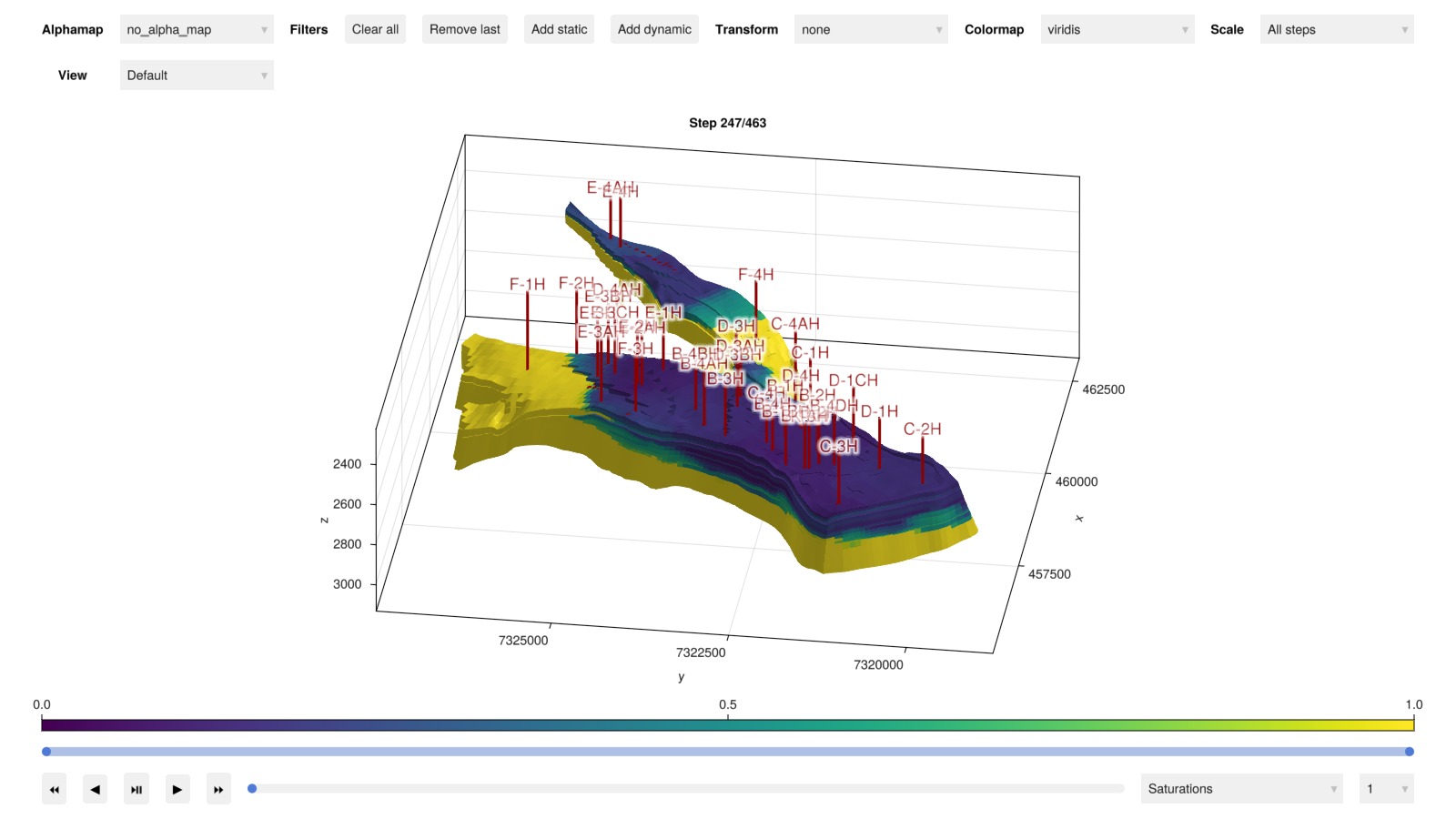
Load reference and set up plotting
julia
csv_path = joinpath(norne_dir, "REFERENCE.CSV")
data, header = readdlm(csv_path, ',', header = true)
time_ref = data[:, 1]
time_jutul = deepcopy(ws.time)
wells = deepcopy(ws.wells)
wnames = collect(keys(wells))
nw = length(wnames)
day = si_unit(:day)
cmap = :tableau_hue_circle
inj = Symbol[]
prod = Symbol[]
for (wellname, well) in pairs(wells)
qts = well[:wrat] + well[:orat] + well[:grat]
if sum(qts) > 0
push!(inj, wellname)
else
push!(prod, wellname)
end
end
function plot_well_comparison(response, well_names, reponse_name = "$response")
fig = Figure(size = (1000, 400))
if response == :bhp
ys = 1/si_unit(:bar)
yl = "Bottom hole pressure / Bar"
elseif response == :wrat
ys = si_unit(:day)
yl = "Surface water rate / m³/day"
elseif response == :grat
ys = si_unit(:day)/1e6
yl = "Surface gas rate / 10⁶ m³/day"
elseif response == :orat
ys = si_unit(:day)/(1000*si_unit(:stb))
yl = "Surface oil rate / 10³ stb/day"
else
error("$response not ready.")
end
welltypes = []
ax = Axis(fig[1:4, 1], xlabel = "Time / days", ylabel = yl)
i = 1
linehandles = []
linelabels = []
for well_name in well_names
well = wells[well_name]
label_in_csv = "$well_name:$response"
ref_pos = findfirst(x -> x == label_in_csv, vec(header))
qoi = copy(well[response]).*ys
qoi_ref = data[:, ref_pos].*ys
tot_rate = copy(well[:rate])
@. qoi[tot_rate == 0] = NaN
grat_ref = data[:, findfirst(x -> x == "$well_name:grat", vec(header))]
orat_ref = data[:, findfirst(x -> x == "$well_name:orat", vec(header))]
wrat_ref = data[:, findfirst(x -> x == "$well_name:wrat", vec(header))]
tot_rate_ref = grat_ref + orat_ref + wrat_ref
@. qoi_ref[tot_rate_ref == 0] = NaN
crange = (1, max(length(well_names), 2))
lh = lines!(ax, time_jutul./day, abs.(qoi),
color = i,
colorrange = crange,
label = "$well_name", colormap = cmap
)
push!(linehandles, lh)
push!(linelabels, "$well_name")
lines!(ax, time_ref./day, abs.(qoi_ref),
color = i,
colorrange = crange,
linestyle = :dash,
colormap = cmap
)
i += 1
end
l1 = LineElement(color = :black, linestyle = nothing)
l2 = LineElement(color = :black, linestyle = :dash)
Legend(fig[1:3, 2], linehandles, linelabels, nbanks = 3)
Legend(fig[4, 2], [l1, l2], ["JutulDarcy.jl", "OPM Flow"])
fig
endplot_well_comparison (generic function with 2 methods)Injector bhp
julia
plot_well_comparison(:bhp, inj, "Bottom hole pressure")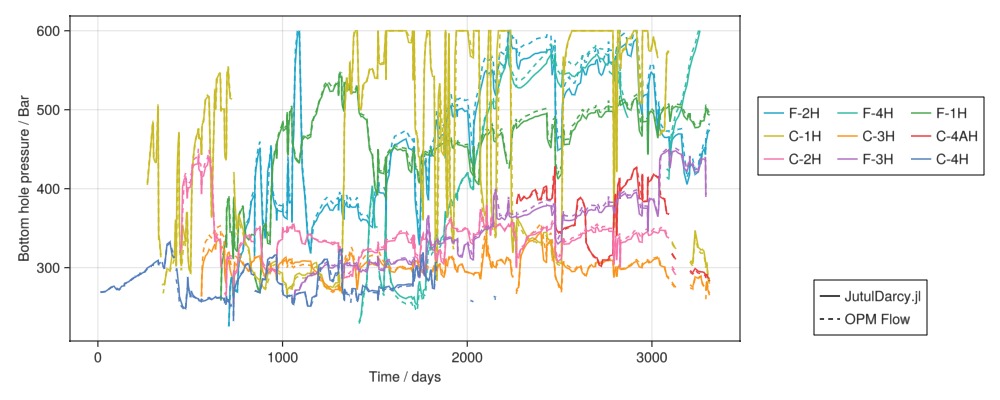
Gas injection rates
julia
plot_well_comparison(:grat, inj, "Gas surface injection rate")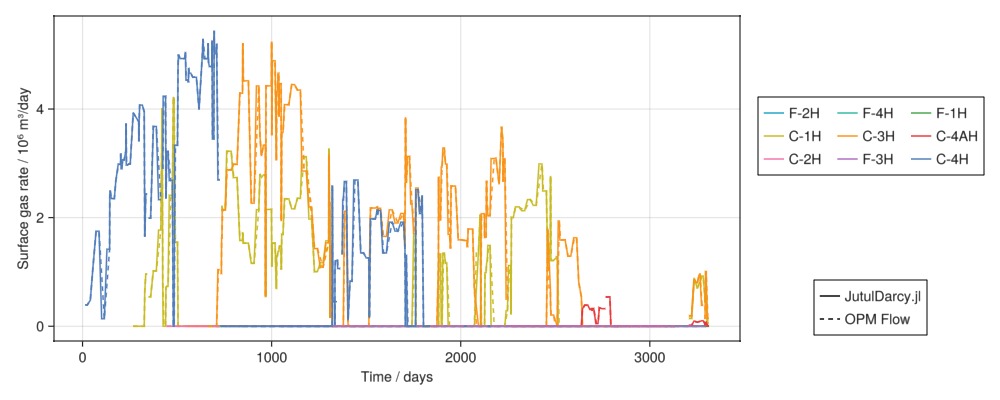
Water injection rates
julia
plot_well_comparison(:wrat, inj, "Water surface injection rate")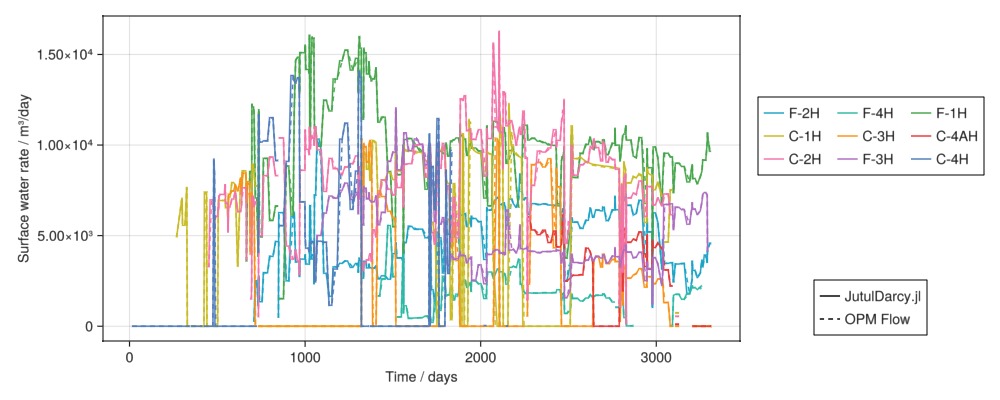
Producer bhp
julia
plot_well_comparison(:bhp, prod, "Bottom hole pressure")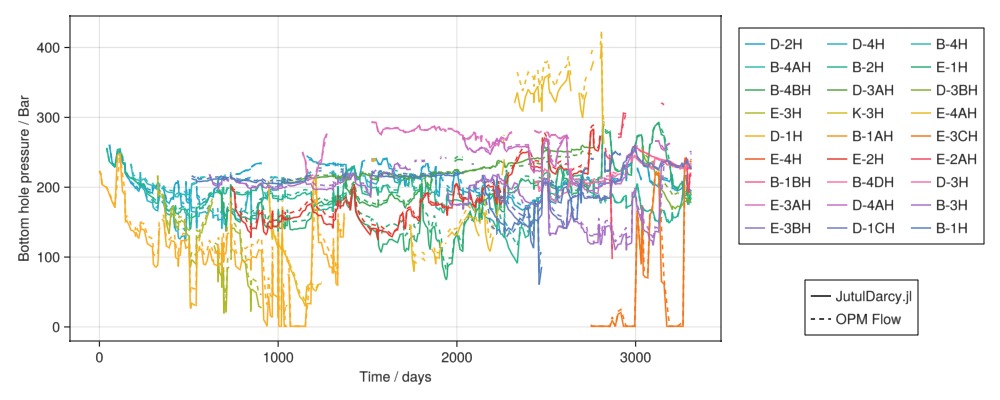
Oil production rates
julia
plot_well_comparison(:orat, prod, "Oil surface production rate")
Gas production rates
julia
plot_well_comparison(:grat, prod, "Gas surface production rate")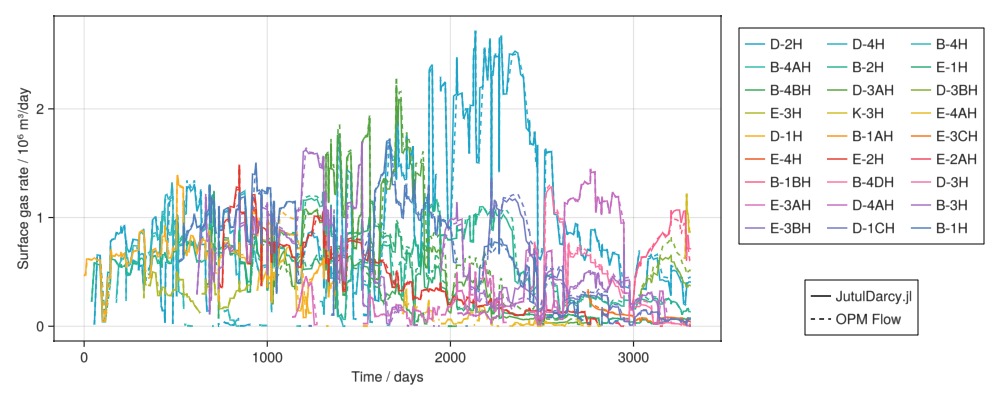
Example on GitHub
If you would like to run this example yourself, it can be downloaded from the JutulDarcy.jl GitHub repository as a script, or as a Jupyter Notebook
This page was generated using Literate.jl.